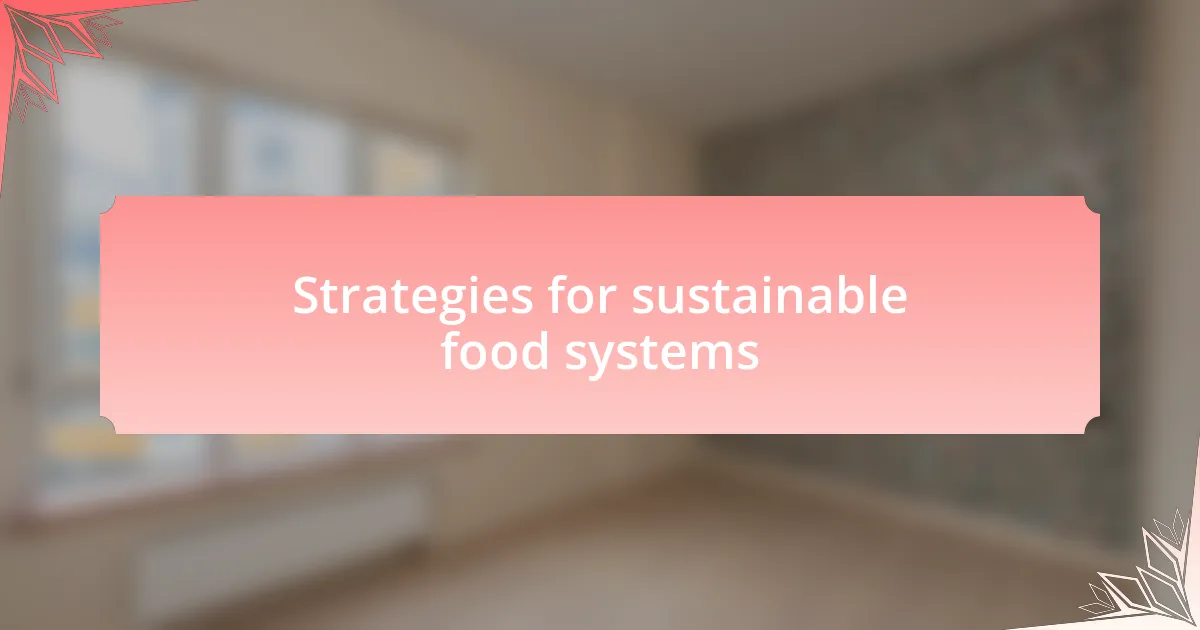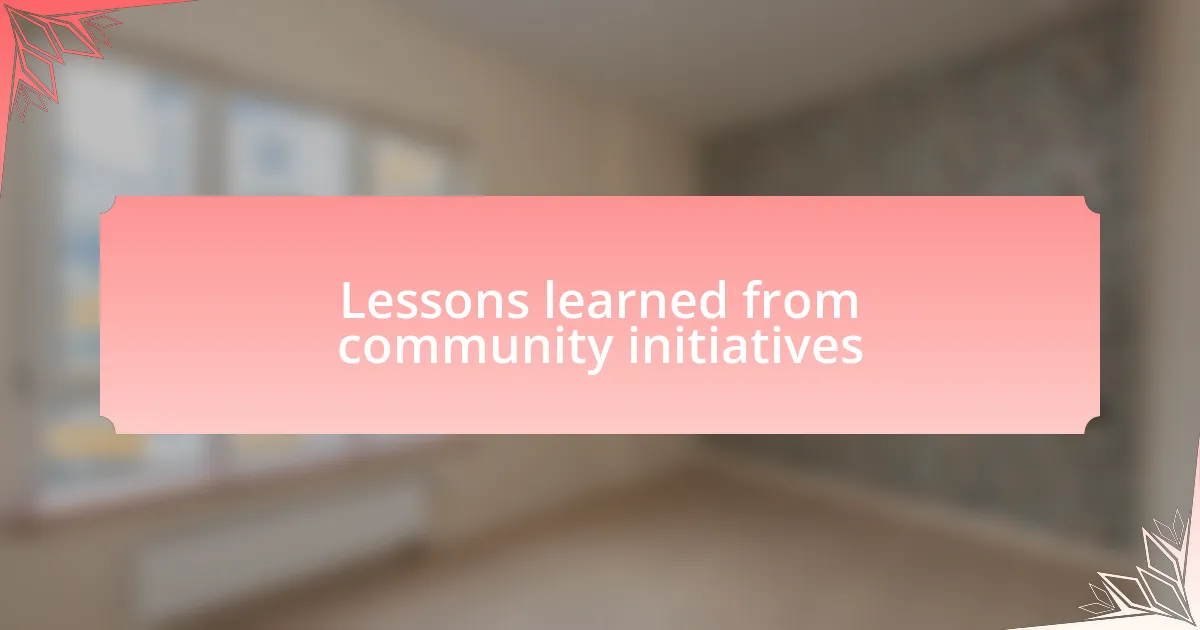Key takeaways:
- Food sovereignty emphasizes local control over food systems and promotes sustainability while preserving cultural traditions.
- Community housing fosters connections, supports diverse populations, and contributes to economic stability.
- The relationship between food and housing influences access to healthy food, highlighting the importance of stable living situations.
- Building local food networks through seed-sharing and farmers’ markets enriches community bonds and appreciation for local agriculture.

Understanding food sovereignty
Food sovereignty is more than just growing what we eat; it’s about reclaiming our connection to the land and food systems. I remember the first time I participated in a community garden. It wasn’t just about the fresh herbs and vegetables; it was the joy of working side by side with neighbors, each of us sharing stories and learning from one another. Have you ever felt that sense of community pride when you harvest your own food? It’s profound.
At its core, food sovereignty emphasizes local control over food production, distribution, and consumption. This concept also champions agricultural practices that respect cultural traditions and promote sustainability. I’ve witnessed how some communities, with roots in farming traditions, are revitalizing heirloom crops. This revival not only nourishes bodies but also fosters cultural identity. Can you imagine the significance of eating food that your ancestors once cultivated?
Moreover, food sovereignty tackles issues of accessibility and justice in food systems. I’ve seen firsthand the frustration when fresh food options are scarce in urban neighborhoods. Reflecting on my experiences in advocacy, it’s clear that empowering communities to have a say in what they eat can lead to healthier populations and a vibrant sense of community. When we advocate for food sovereignty, we aren’t just fighting for our plates; we are championing our rights and futures.

Importance of community housing
Community housing is essential in fostering connections among residents. I recall moving into my first affordable housing project, where neighbors quickly became friends. It’s amazing how a shared space can create a genuine sense of belonging. Have you ever experienced that warmth when people come together under one roof?
The strength of community housing lies in its ability to support diverse populations. When I attended neighborhood meetings, I noticed various voices coming together for common goals. This diversity not only enriches our interactions but also builds resilience, as we learn from each other’s experiences and backgrounds. Isn’t it incredible how much we can accomplish when we unite our strengths?
Additionally, community housing contributes to economic stability. I’ve seen firsthand how stable living environments empower individuals to pursue careers and education. When people feel secure in their homes, it fosters ambition and growth, leading to a thriving local economy. Can you see the ripple effects that arise from simply having a place to call home?

Relationship between food and housing
The connection between food and housing is profound and often overlooked. I remember volunteering at a community garden adjacent to a housing project. Watching families gather to plant seeds not only provided fresh produce but also strengthened their bonds, transforming an empty lot into a thriving hub of activity. Isn’t it amazing how simple acts, like gardening, can create a sense of both food security and community?
Access to healthy food can be heavily influenced by one’s living situation. During my time working in community development, I observed that neighborhoods with stable housing often had better access to grocery stores and farmers’ markets. Conversely, unstable housing situations typically led to reliance on fast food and convenience stores. Have you ever considered how where we live can dictate the quality of what we eat?
Moreover, the act of sharing meals can deepen ties among residents. I once attended a potluck organized in our housing complex, where everyone brought dishes that represented their cultural backgrounds. This gathering was more than just sharing food; it became a way to embrace our diversity and learn from each other. Can you think of a time when a shared meal created lasting memories in your life? In this way, food not only nourishes our bodies but also our sense of community and belonging.

Strategies for sustainable food systems
One effective strategy for sustainable food systems is the promotion of urban agriculture. I remember visiting a rooftop garden where residents collaborated to grow vegetables not only for personal use but also for local food banks. It was inspiring to see how this initiative not only provided fresh produce but also empowered community members to learn about food production and environmental stewardship. How often do we think about the space above our heads as a resource for nourishment?
Another approach involves establishing food co-ops, which can create a cooperative economy model. I participated in a local co-op that sourced produce directly from regional farmers. This experience opened my eyes to the benefits of supporting local agriculture while also ensuring that everyone had access to affordable, fresh food. What if more communities adopted this model, fostering economic resilience and local partnerships?
Lastly, education plays a pivotal role in building sustainable food systems. In my experience, workshops on nutrition and cooking taught in community centers can significantly impact how families view food. I once attended a session where participants learned to prepare healthy meals using seasonal ingredients, leaving everyone feeling empowered and inspired. Isn’t it fascinating how knowledge can spark change and lead us toward healthier choices?

Building local food networks
Developing local food networks often starts with the simple act of connecting neighbors. I still remember the first time I attended a community potluck organized by a local food group. The air was filled with laughter and the aroma of dishes made from homegrown ingredients. It struck me how gathering around food could foster a sense of belonging while simultaneously showcasing the diversity of flavors in our neighborhood.
One effective way to strengthen these networks is by creating seed-sharing programs. I participated in one where community members exchanged heirloom seeds, encouraging sustainable gardening practices and the preservation of unique plant varieties. This initiative not only allowed us to grow food but cultivated relationships among gardeners who shared tips and experiences. Have you ever thought about how a single seed can unite people around a common goal?
Farmers’ markets also play a crucial role in connecting local producers with consumers, transforming the way we access food. I often visit my local market, where I cherish the interactions with farmers who share stories about their growing practices. It’s a vivid reminder of how understanding the origin of our food can cultivate a deeper appreciation for it. What if every community had a vibrant market that celebrated local culture and nurtured these vital connections?

Personal experiences in community projects
Participating in community garden projects has profoundly impacted my understanding of collaboration and food sovereignty. I recall volunteering at a local garden where we transformed a vacant lot into a flourishing space. Digging my hands into the soil, I felt a genuine connection with my neighbors who shared their stories of struggle and resilience. Have you ever felt so connected to a piece of land that it felt like a heartbeat?
In another project, I joined a group focused on urban farming education. Teaching workshops on sustainable practices, I witnessed firsthand the excitement of newcomers learning how to grow their own food. One participant, a young mother, expressed how growing vegetables together could empower her family to make healthier choices. Isn’t it inspiring how food can become a source of empowerment and hope within a community?
Lastly, I attended a food sovereignty conference that unveiled the deep-rooted issues many communities face regarding access to nutritious food. Hearing testimonials from individuals advocating for local policy changes was moving. Their passion reignited my commitment to these causes, prompting me to ask: how can we harness our collective voices to ensure that everyone has access to healthy food?

Lessons learned from community initiatives
It’s fascinating how community initiatives can reveal the power of shared goals. During a workshop on community resilience, I learned that when we align our efforts around common interests, such as food sovereignty, we create lasting bonds. Have you noticed how a single community meal can bring people together, fostering a sense of belonging and cooperation?
Throughout various projects, I’ve observed that flexibility is key. One summer, while helping to establish a cooperative grocery store, our team faced numerous setbacks, from funding issues to fluctuating community interest. In those moments, I realized that adaptability not only keeps a project alive but also strengthens relationships among participants. Isn’t it enlightening how challenges often become catalysts for deeper connections and innovative solutions?
In a recent initiative, we organized a pop-up market featuring local farmers. This experience taught me the importance of amplifying marginalized voices in food systems. Witnessing farmers share their struggles and triumphs while supporting each other was powerful. It made me ask myself: how can we ensure that everyone, especially those traditionally underserved, has a seat at the table in shaping our food environments?